Serving up the perfect jewelry piece to your customers is more important than ever in today’s increasingly competitive eCommerce ecosystem. How can brands make the search for the right jewelry effortless?
As the retail landscape tightens due to an uncertain economy, delivering thoughtful online shopping experiences that can easily connect customers to the right products has become imperative. The faster shoppers can find relevant items on your site, the more they’ll be willing to explore, add jewelry pieces to their carts, and buy them.
With the value of the online jewelry market expected to grow to $60 billion worldwide by 2027, putting up a standard eCommerce website is no longer enough. To stand out, robust product discovery must nurture shoppers down the purchase path, while ensuring that they experience a smooth buying journey that inspires brand loyalty.
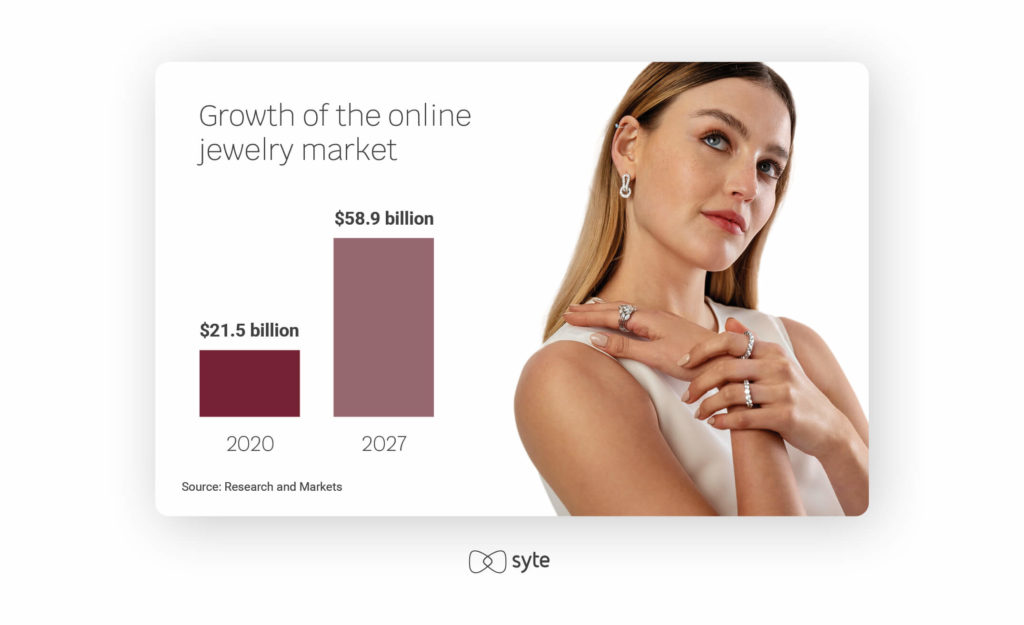
In this guide, we’ll cover everything there is to know about product discovery for jewelry brands, from the benefits and strategies to advanced technologies and brand inspiration for seamless shopping.
The Unique Position of Jewelry in eCommerce
eCommerce is a great equalizer for brands and retailers. Brands are not bound by geography, making it possible to reach shoppers globally so long as they have internet access. Having an online presence is also an expectation among customers now, and so is the ease of buying and delivery.
The reality, however, is that setting up an eCommerce channel is not as simple for jewelry brands. Online competition is tough. Jewelry pieces are high-ticket purchases requiring scrutiny from buyers. Shopping for jewelry also has a lot to do with deciding based on touch and feel. Because of the value placed on jewelry in terms of price and sentiment, the online buying journey ends up tedious and complex. Details such as the type of stone, materials used, style, and size all matter in finding the perfect piece. For laymen, it’s difficult to describe the look of jewelry using words, which, in brick-and-mortar stores, is where personal shoppers and store assistants come in handy.
With these challenges is where building confidence and trust through seamless digital customer journeys, from product search to purchase and fulfillment, comes in – and it all starts and ends with effective product discovery. Let’s find out why.
Product Discovery and Search for Jewelry
Searching for the perfect jewelry, like every product search journey today, is hardly a straightforward process. The common assumption is that product discovery only happens during the early stages of the shopping journey. But the truth is that it can and will take place at any point. Customers find purchase ideas from various sources, both online and offline, from the pages of a celebrity gossip magazine to a friend’s new bathroom wallpaper.
Because this inspiration is everywhere, from influencers’ posts to friends’ outfits, it’s up to brands to make sure that customers find their products at the right place and time.Surfacing relevant content quickly is critical, because most shoppers do not have time or energy to look through your entire inventory.
As we’ll discuss later, eCommerce brands have plenty of options for optimizing product discovery and jewelry shopping. Consumers can explore products through text and visual search, data-driven visual merchandising, recommendation carousels, special landing pages, inspirational galleries, and more. With at least 49% of shoppers saying that they use Google to find new products, relevant ads coupled with robust product descriptions and tags can also improve your site’s chances of being “discovered” on a search engine.
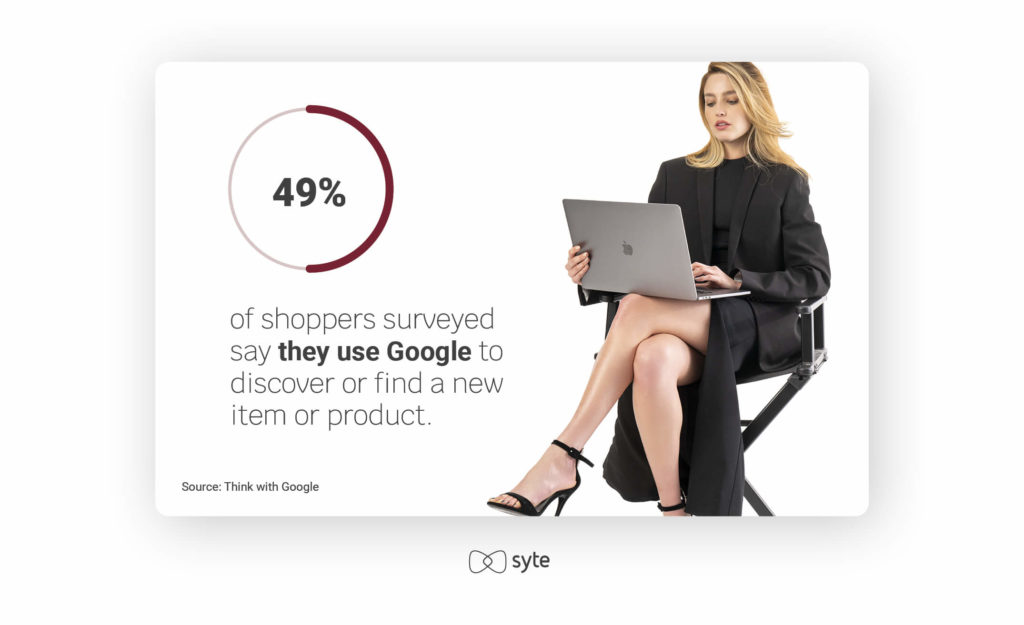
Why Seamless Product Discovery is Essential for Jewelry eCommerce Brands
Jewelry brands need to deliver effective and relevant product discovery experiences to attract, engage, and retain shoppers. It’s an essential part of the customer journey because so much depends on it, including revenue goals, brand perception, and online following. Here are some of the reasons effective online product discovery is crucial for successful jewelry eCommerce brands today.
The Growing Market of Online Jewelry Sales
The projected ebullient growth of the online jewelry market is undoubtedly expedited by the pandemic, which pushed customers to become more fluent at online shopping in a condensed time period. In 2020, while most US shoppers preferred to actually purchase their jewelry in physical retail stores, 69% of those still chose to shop around online. There was a dip in jewelry purchases in the same year, but online purchases have seen a slight uptick.
Still, the jewelry and watch industries are expected to rebound in the next few years. Mckinsey predicts a 3-4% growth rate per year until 2025. Online jewelry sales is projected to account for 18-21% of the total global jewelry market in the same time period.
What do all of these numbers mean? Shopping for jewelry online is a rapidly growing space with a lot of potential, but consumers are surrounded by multiple distractions and choices. To capture their attention, brands must deliver exceptional buying journeys and surface relevant products and experiences every step of the way.
Convenience is the name of the game. Online stores allow customers to leaf through product pages at any hour, without time constraints. It attracts everyone from inexperienced shoppers who might be intimidated by the idea of stepping into an upscale store or a boutique to digital natives who are purchasing fine jewelry for the first time. Virtual shopping offers the luxury of endless time to browse and decide.
The search-to-buy process online is not as linear as a traditional in-store purchase. Customers can have up to four touchpoints before deciding to purchase, according to Google and Ipsos. Consumers are also engaging brands across multiple channels, partly driven by the pandemic, and around 86% of consumers intend to maintain their usage of various engagement points. Because it’s so commonplace to shift between devices, with 90% of multiple device owners switching between screens in at least three combinations every day, consumers will naturally interact with brands on different channels and various devices, and can get inspiration and begin product discovery in countless ways.
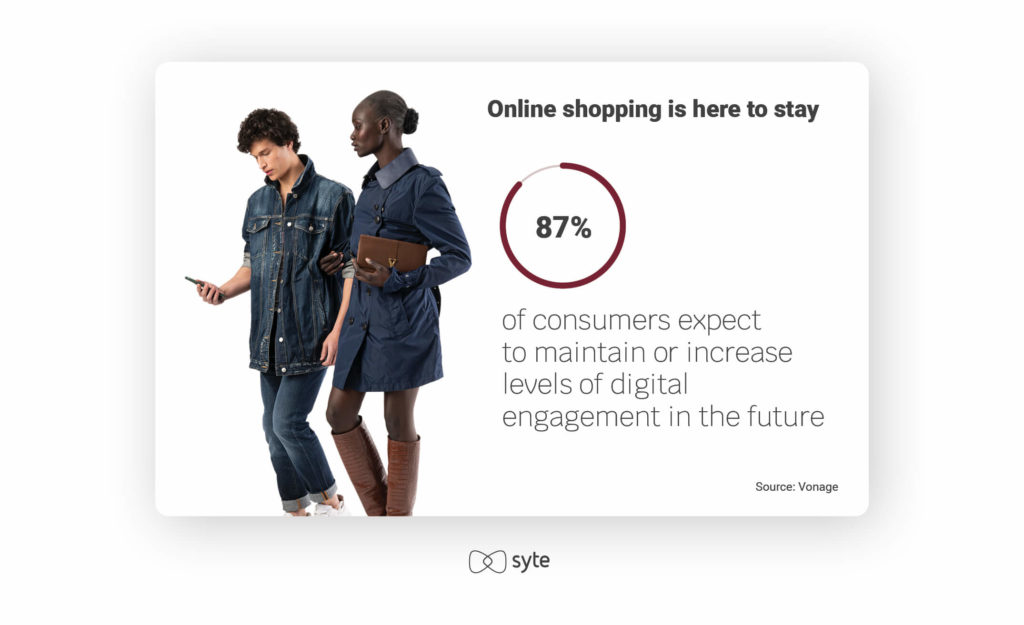
Having constant access to new content on social media has also affected consumer expectations. Users expect timely answers from brands through their social media channels, the same way they can post a photo and watch the likes and comments pile up in a matter of minutes. The accessibility of online channels 24 hours a day has also heightened the desire for excellent customer service – consumers expect to be provided with details such as stock updates, pricing info, and delivery dates in an instant.
Rising Competition
For the longest time, traditional retail and multi-brand retailers have had the biggest share of the hard luxury (timeless items such as jewelry and watches) industry’s global revenue. In today’s increasingly digital world, however, that market share is rapidly changing.
D2C brands can provide added value by eliminating the middlemen, providing lower costs, and controlling the entire process, from manufacture to distribution. According to McKinsey, these advantages will cost traditional retailers $2.4 billion in revenue lost to D2C brands, by 2025. The transition will be a challenge for jewelry brands that have not made the transition to digital. An online presence built on effective product discovery will put your site on top in today’s changing consumer and market landscape.
Providing Equivalent In-store Experiences to Modern Shoppers Online
While convenience is a major driver for customers to shop online, it is not enough for many industries, including the jewelry and watch verticals. For expensive purchases that are often tied to special occasions and carry sentimental value, some customers feel more comfortable with the social, face-to-face component afforded by physical retail stores. The shopping experience in brick-and-mortar stores is also a highly visual one, involving the selection and inspection of fine pieces.
Going online does not necessarily mean giving up the pleasures of in-person shopping. The right eCommerce tools and technologies can recreate the experience on your website and personalize the service. Brands and retailers can tailor the product discovery journey, down to details like showcased collections with visual merchandising. Relevant product recommendations from product detail pages to checkout pages can provide more value than a sales associate might.
The Costs of Poor eCommerce Search and Discovery
Inspiration can strike consumers anywhere, like a necklace worn on a Netflix series, influencers promoting brand partnerships, or loved ones recommending favorite products. For many shoppers, their first step is to search for similar items on the web. They go online first on over 60% of shopping occasions. However, even with the wide usage of search engines, there’s often a disconnect between discovering and finding a product.
Customers also face another issue in their eCommerce jewelry search: Most of the time, they don’t know how to describe what they want to purchase. The average shopper is not fluent in the jargon of precious stones and metals. They might try experimenting with different features such as style and brand to generate the most relevant results. But many search engines lack the infrastructure to support intuitive queries.
Seventy percent of search engines require users to search with the exact same product language as the site. Meanwhile, 60% don’t support thematic search queries and 84% don’t handle queries with subjective qualifiers. As a result, customers may be left unsatisfied in their search for the perfect diamond or ring, and will be prompted to seek other trusted brands and retailers.
This is a problem because effective search is among the foundations of product discovery. With the right tools such as image search for jewelry, brands can connect customers to the most similar items in their inventory. If a website lacks a robust search tool, shoppers will have to scroll through pages and pages of product listings. They won’t always have the time to and can choose to leave for the competition.
Better Product Discovery = Better Customer Experience
For brands and retailers, the value of effective product discovery cannot be underestimated. It dictates the entire customer experience. An issue arising from the search process can negatively impact customers’ impressions of your brand. Shoppers will quickly decide to cut ties, even with a brand they trust; for 86% of shoppers, it only takes two poor customer experiences.
On the flip side, successfully executed product discovery can lead to better customer experiences that increase brand awareness, customer loyalty, and conversion rate. Here are some benefits of robust product discovery:
- Visibility – Brands and retailers can meet shoppers where they are at the most opportune moment, both on- and off-site.
- Relevance. By understanding context and intent, the right jewelry pieces surface at the right time throughout the customer journey.
- Ease of use. From site search to navigation, shoppers can quickly locate the item they have in mind, buy it, and leave your website satisfied.
- Personal. Customers feel seen and heard, especially with concerns surrounding the search and purchase of precious metals and stones.
Together, these factors build and nurture trust, an important element in online jewelry shopping. With 74% of consumers likely to buy based on experiences alone, trust is critical. Plus, if they’re satisfied, they’ll pass the word along to friends and family. The Salesforce “State of the Connected Customer” report found that 72% of customers will share their good experiences with others.
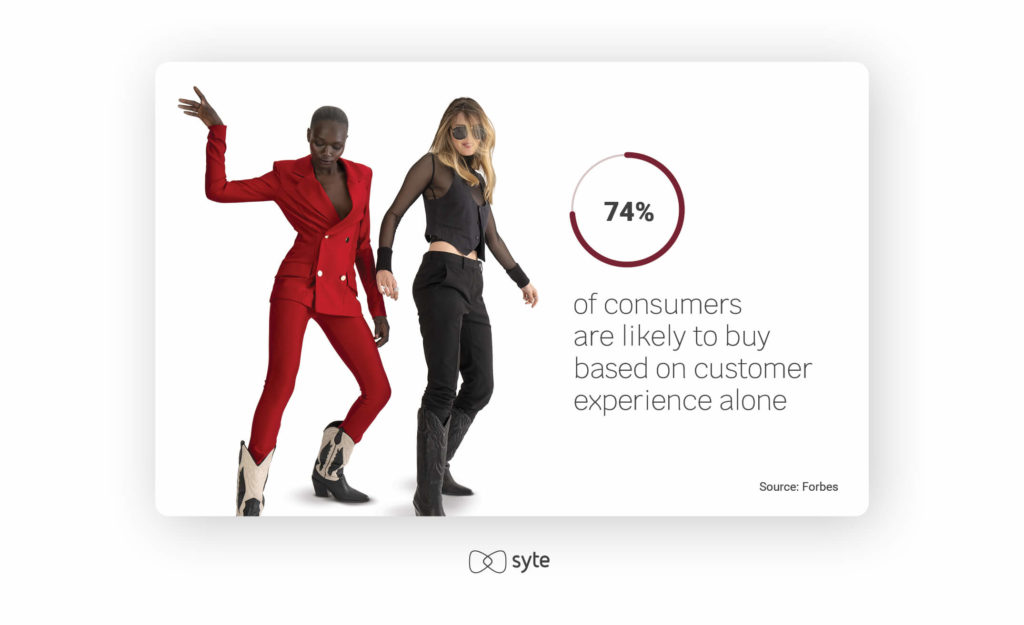
7 Simple Ways to Help Shoppers Find the Right Jewelry
To make jewelry shopping less of a daunting experience for customers, here are some simple yet impactful measures brands can implement to surface the most appropriate pieces for each shopper. Buying or gifting jewelry is a personal, emotionally driven process. Shoppers expect to be served a similarly heartfelt customer journey. It’s imperative that eCommerce brands showcase relevant products, give shoppers a reason to trust, and create experiences that set the bar high so that customers won’t hesitate to return to your site.
1. Always Keep Your Homepage Fresh
If it hasn’t been emphasized enough: first impressions matter. Websites only have 50 milliseconds to make a good impression, and 38% of visitors will leave if what they find is lacking. It’s akin to passing by a boutique window and checking out what the store has to offer. In a short amount of time, you should be able to grab your shoppers’ attention, perhaps by showcasing special jewelry collections, trending pieces, new arrivals, or user-generated content.
The bottom line is that the homepage should be the place where all the best you have to offer is on display. Failure to capture your visitors’ interest in an inviting way may cause them to leave and restart the discovery process elsewhere.
2. Experiment With Different Media and Content
Videos may be the most engaging type of content there is — 54% of marketers say it’s the most valuable in achieving marketing goals. But brands have many other options. Websites can publish editorials, infographics, interactive quizzes, and even immersive games.
Guides, in particular, can augment customers’ knowledge. By packaging engaging media and content into a guide geared towards customer education, jewelry brands have the chance to brand themselves as credible industry experts in hard luxury shopping. After they’ve done their research and landed on your site, your content can empower customers to make a successful and satisfying purchase.
3. Be Present on Relevant Channels
Social media, especially visual-based platforms, are excellent for introducing your brand and your products to new customers. You can improve brand perception by implying that you keep up with the times and posting captivating yet value-rich photos and descriptions. Having a social media presence communicates to your market and your followers that you are willing to build a relationship with them – interacting is as easy as liking and leaving comments.
There’s also an optimal opportunity for extending product recommendations through influencers and friends. Today’s shoppers value reviews and suggestions made by people they trust, and tapping into key personalities in their networks can be an effective strategy for brand awareness and product promotion.
4. Optimize Your Mobile App
Meet customers where they are. This is good advice for channels, but it also applies to devices. Mobile is an important one to get right for jewelry brands. In 2021 alone, retail m-commerce sales in the United States exceeded $360 billion. By 2025, the number is predicted to double. Fine jewelry cannot afford to neglect its mobile app options.
Your app, installed on your shoppers’ mobile phones, provides multiple opportunities for product discovery, from in-app pop-ups to push notifications. It’s also more intimate and instantly gratifying. Imagine a shopper who comes across a piece of jewelry that piques their interest. Instead of a search on an external search engine, they can simply go to your mobile app to find it.
5. Make Sure Photos Are High Quality
When shopping in jewelry boutiques or stores, customers can view and inspect pieces up close. While the opportunity for manual inspection is not available in the digital shopping experience, jewelry shoppers can still examine products carefully by viewing high-quality photos that show the pieces from multiple angles or a zoom-in view. Online brands can even offer 360-degree displays to help customers visualize the product better. Viewing high-resolution product photos can be a decent substitute for touching and feeling the actual product, but they have to be detailed enough to inspire customers’ confidence.
6. Improve Navigation
It can be confusing to buy jewelry, especially with the myriad of styles, stones, and materials to consider. Customers might also have trouble describing the piece they want in words. Improve your shoppers’ experiences by clearly labeling your navigation menu with easily understandable terms. You can also supplement with visual navigation so that browsing visitors can easily switch between types of jewelry, designs, and colors with the guidance of images or icons. The navigation should be logically structured and informative, so shoppers can easily find their way around your site and inventory.
7. Simplify Filtering
Filters are another means of enabling shoppers to find the perfect jewelry pieces as quickly as possible. Comprehensive and accurate filters allow seamless exploration and search on your site. Like the navigation menu, filters must also be clearly labeled so visitors can refine their searches.
You can also implement faceted search to highlight more in-depth filters that, at the same time, educate shoppers about the characteristics of the jewelry you carry. This means having different filters for different product categories. For instance, band materials for watches or cuts for diamonds can serve as filters. These divisions are clear and category-focused, which can help shoppers narrow down their options to the pieces that are most relevant to them.
How to Elevate the Jewelry Search Experience With Advanced Technologies
Fine jewelry is often a special purchase. Customers generally shop in this area when an important occasion is coming up, like an anniversary or a birthday. When they do, they tend to do extensive research and compare deals online.
Jewelry brands can offer customers more convincing reasons to buy through advanced jewelry search technologies that allow for easier discovery, examination, and comparison. These tools also make it possible for eCommerce brands to provide premium services to customers — the same way you would in a physical store — while keeping the purchasing process secure. Here are seven ways you can use the latest tools to elevate the online jewelry search experience.
1. Empower Shoppers to Search With an Image
Visual search for jewelry addresses the limitations of text-based search. It’s especially helpful for verticals like jewelry, where customers are not always well versed in the terms used for styles, stones, and materials. Instead of figuring out the right keywords to include in a search query, customers can simply upload a photo or screenshot, and voila! They are presented with a list of similar items.
Also known as image search or camera search, visual search works by combining the AI disciplines of computer vision and deep learning. It analyzes each pixel, identifies each object in a photo, and then presents similar images to the seeker. In a vertical like fine jewelry, with complex offerings and seemingly endless selection, visual search transcends barriers in language and knowledge.
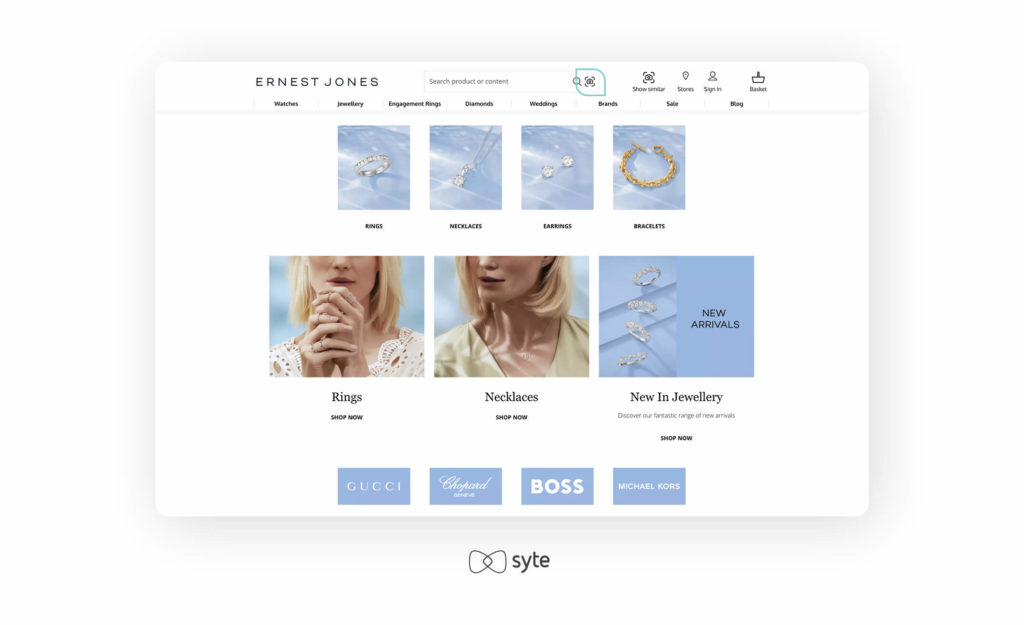
2. Streamline Inventory and Operations With Deep Product Tags
Accurate, consistent, and updated product tags are one of the core foundations of effective on-site product discovery. With visual AI, brands can automatically tag products and enrich their descriptions with visual details, synonyms, and textures so that the jewelry search process becomes more intuitive.
In terms of the customer experience, product tags help surface the most relevant results first based on context, even if the terms used in the search are different. Moreover, the tags in your product descriptions serve as metadata for search engines. When they are robust and up to date, they can make your jewelry pieces discoverable in Google results, as well.
On the backend, robust product tags can be used to streamline brand inventory and inform business decisions. Search data can help you analyze trends, predict demand, and optimize operations accordingly, increasing efficiency and reducing waste.
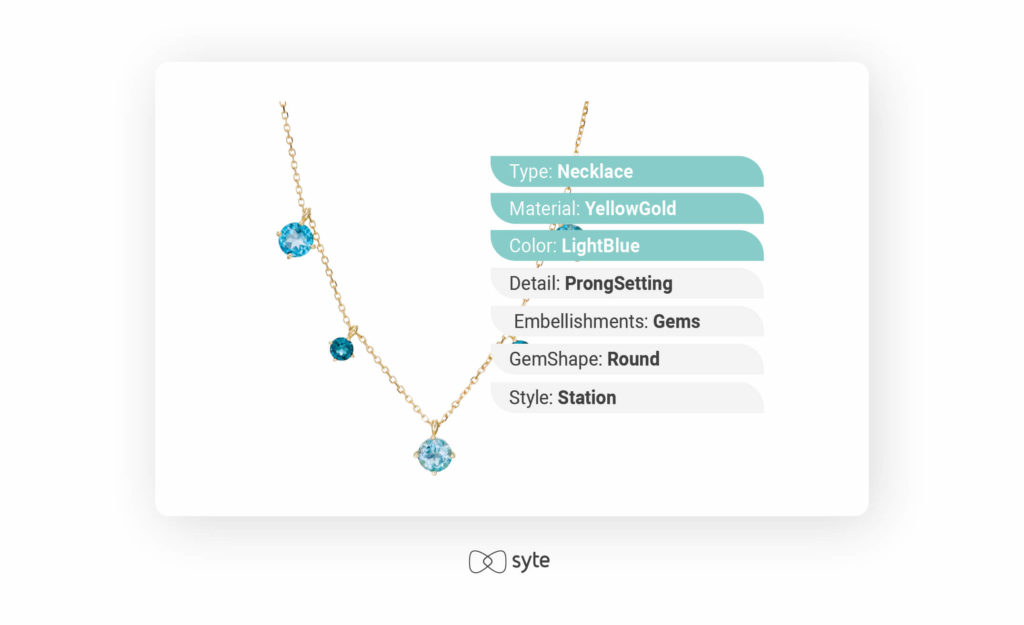
3. Customize Search Results and Pricing
Strategic design and layout of search results and pricing information plays an important part in ensuring that customers will discover the products that are most relevant for them and make them more likely to complete their purchases. It’s important to plan how best to display your SKUs, regardless of whether it’s on your homepage, search results, or product pages.
Having the capability to group, rank, and present merchandise provide brands with opportunities to not only improve product discovery but also have more control in reaching business goals. Done right, it would be similar to how a brick-and-mortar store would decorate its interiors and display relevant products to entice customers.
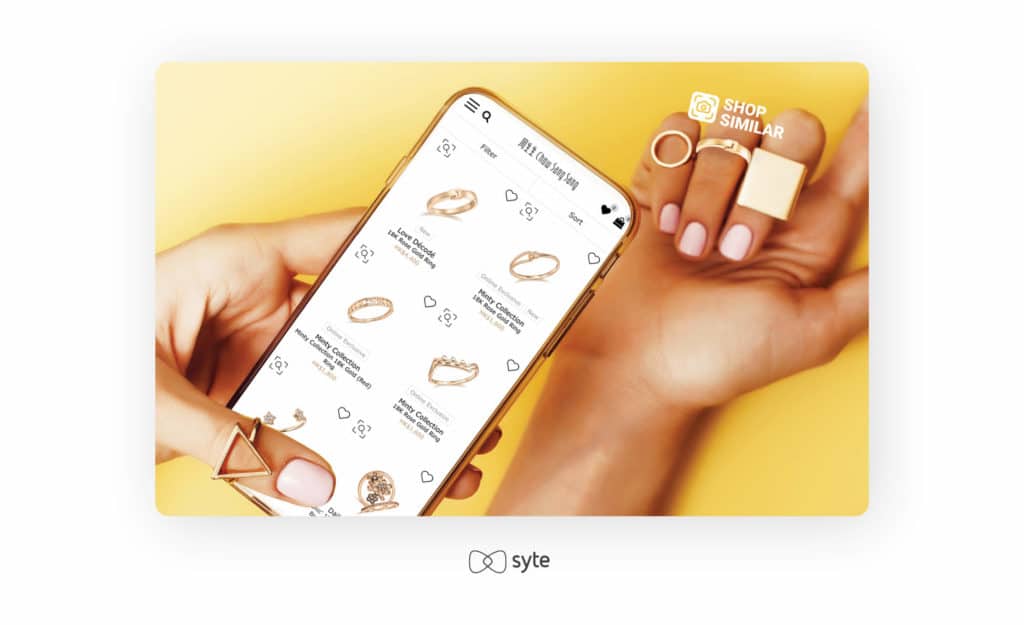
4. Recommend Relevant Products
The digital shoppers of today deal with an overload of information. Ideally, your site visitors would only devote their time and attention to products that are ideally suited to them. Recommendation engines fulfill that for them by presenting only the most relevant items in your brand inventory. You can make use of a visual AI algorithm that filters results based on prior interactions and user preferences. This makes the decision process easier for customers, resulting in increased engagement and basket size. When shoppers feel that you have a good handle on their preferences, they’re more likely to remember you the next time they are jewelry shopping.
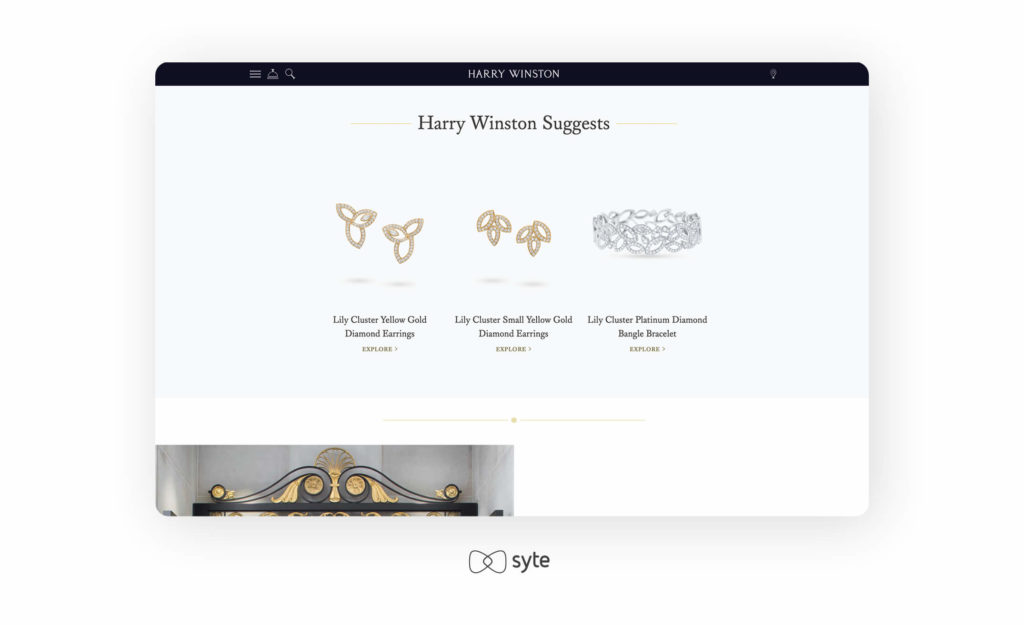
5. Make Data-Driven Decisions
Analytics has a profound impact on eCommerce and product discovery. Enrich it with visual data, and you’re giving your customers more opportunities to intersect with products they might like. In addition to better product tags, the insights from visual data ensure that, for example, camera search results accurately reflect the style of jewelry that customers are searching for. The information gathered can then inform product development, supply chain processes, and marketing and advertising campaigns.
6. Bridge the Online and Offline Gap
A smart mirror is an interactive tool that bridges the gap between online and offline. In your stores, it can help customers sift through your jewelry pieces to visualize what earrings would suit them best, easily narrowing their search. Even better, if they have already created an account on your site and added jewelry to their wish list or shopping cart, an interactive mirror can simply pull up the pieces for your staff when shoppers drop by your physical store. A smart mirror ensures that shopping experiences are continuous, wherever customers choose to explore products and finalize a purchase.
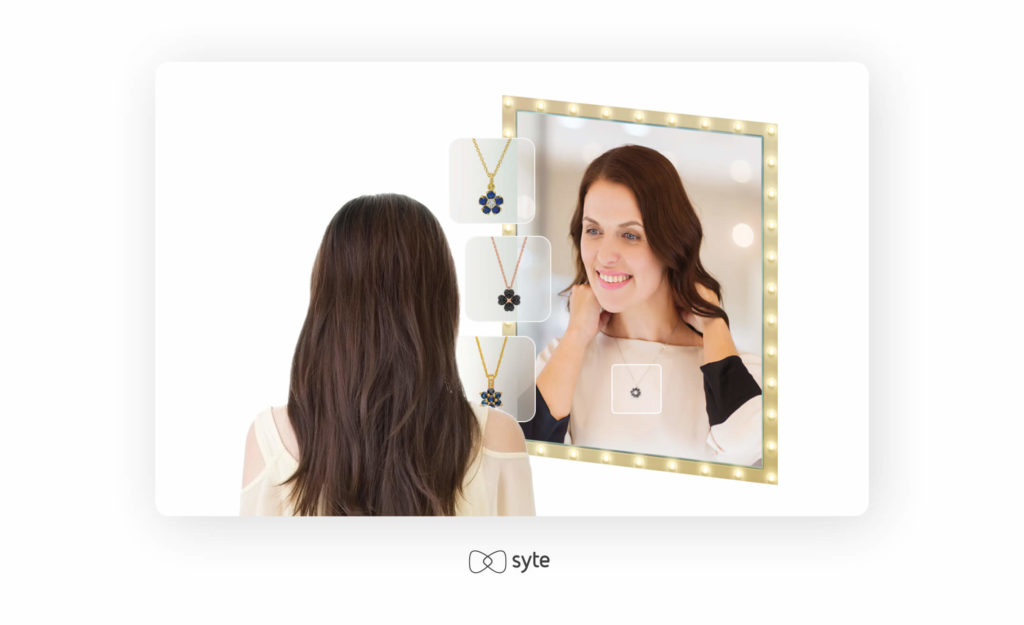
7. Personalize the Customer Experience
Effective personalization techniques dig deeper than just basic demographic divisions. With around 66% of customers wanting brands to understand their unique needs and expectations, customized and connected journeys are table stakes for businesses to compete. Deeper personalization determines the unique preferences and real-time context of shoppers. It acknowledges and detects the changes in the motivations and intentions of customers, and consequently, adapts to tailor the user experience, product discovery, and communication.
There are several ways to make personalization more robust. One of them is integrating visual AI into your backend tech. By leveraging shoppers’ unique interactions with visual assets on site and customizing the experience accordingly, customers feel that they’re understood and trust that brands can provide what they desire.
Combine this with personal shopping services like VIP consultations and timely customer support, and you can create memorable experiences that make shoppers feel special – resulting in better engagement, conversions, and customer loyalty. After all, customer-centric companies are 60% more profitable than companies that are not.
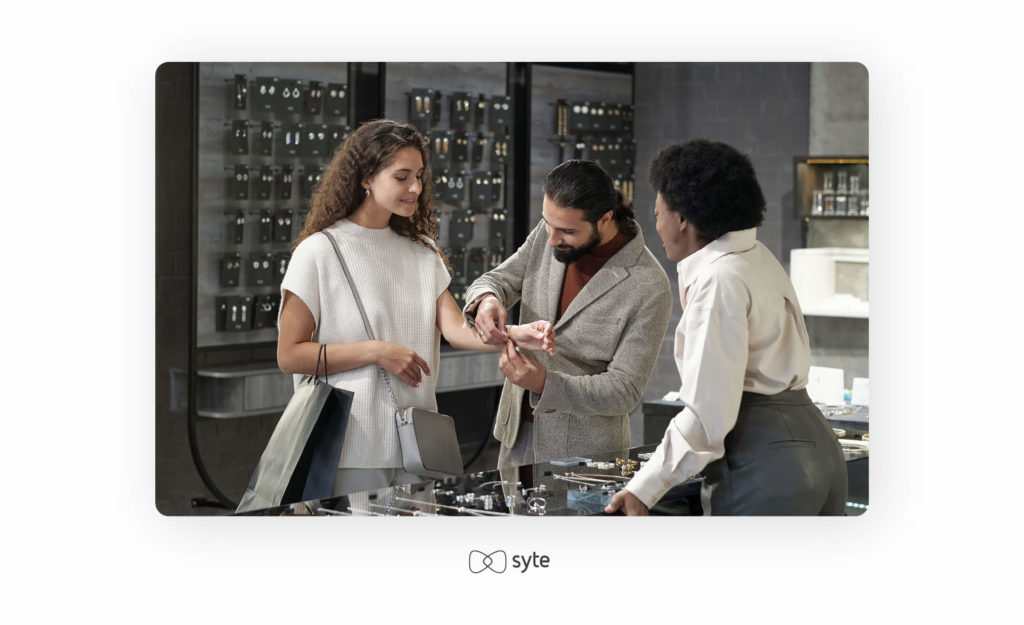
3 Examples of Jewelry Brands Delivering Seamless Product Discovery Experiences
To stand out as the ultimate destination for hard luxury, jewelry brands will have to create experiences that encourage trust, promote relationship building, and give customers a beeline to the perfect products. Here are three examples that provide some tips on how to deliver seamless product discovery experiences.
- En Route
The New York-based jeweler may be a small team, but they have a sizable following on social media, particularly on Instagram and TikTok. The brand regularly posts style inspirations on the platform, with models wearing pieces that are shoppable on En Route’s website. A self-proclaimed home of Gen Z-inspired accessories, En Route is active on TikTok, releasing frequent short video content and interacting regularly with followers. The jeweler often collaborates with Gen Z influencers, including Cindy Kimberly and Luna Montana, expanding the brand’s reach to younger jewelry shoppers.
The made-to-order experience does not stop there. En Route’s website is a treasure trove of inspiration. Lookbooks and jewelry gift guides offer insights on the next big trend. Pieces intended as gifts are also divided into occasions – from Valentine’s day to prom to jewelry for mom.

- Chow Sang Sang
Chow Sang Sang, an 80-year-old jewelry retailer, has made sure to stay relevant by keeping current with emerging technologies. With an inventory of around 10,000 jewelry pieces, it’s essential for this Chinese brand to make the search for the perfect bijouterie on its website easy, accurate, and fast.
No matter what you’re looking for, whether it’s gold or silver, diamonds or pearls, the retailer’s camera search function finds items that exactly match or closely resemble your photo. It also has related features like a Discovery Button and Shop Similar recommendation carousel, presenting options that appeal to individual tastes.

- Tiffany & Co.
Tiffany & Co. has long been associated with diamonds. Both online and offline, the venerable retailer has taken every opportunity to establish itself as the authority on the world’s most popular gemstone. Its comprehensive Guide to Diamonds discusses everything from cut to carat, while promoting its diamonds crafted by the world’s top artisans. Tiffany & Co. also provides information in the form of a video to appeal to visual learners. Shoppers interested in engagement rings or even personal diamond pieces can learn all about diamond shapes, styles, and settings, and shop more confidently after absorbing the data.
The jewelry retailer offers other useful consumer information guides, such as The Modern Man’s Guide to Wearing Jewelry. Moreover, diamond shoppers can browse persona-based collections for the ultimate gem.
What’s Next for Product Discovery?
Hard luxury’s transition to eCommerce may have been slower than other verticals. But with the latest product discovery opportunities and enabling technologies, every website can easily implement the tools to deliver the same experiences as the most popular online brands.
The future holds something exciting for the retail industry in general. While brands and retailers have begun embracing omnichannel experiences, the concept of a metaverse is bubbling up. According to Morgan Stanley analysts, luxury brands can find success selling virtually in the metaverse. This market could balloon to $57 billion by 2030. “Jewelry is the perfect category for the metaverse,” says Syama Meagher, CEO and Chief Retail Strategist of Scaling Retail, on nationaljeweler.com. “It is collectible by nature, perfect for collaborations, and carries more brand loyalty than clothing.”
Many luxury brands have already jumped on the metaverse bandwagon. A Metaverse Fashion Week was held in March 2022, and non-fungible tokens (NFTs) are also on the rise. Digital natives, in particular Gen Z consumers, have adapted quickly to the virtual space. With this generation’s spending power on the rise, they are a fast-growing target for brands and retailers in the metaverse. Some brands are offering the opportunity to purchase jewelry matched with a digital option that their avatars can wear in the metaverse. Alternatively, some are making purchases of digital jewelry redeemable for real-life, physical wearables.
In addition to these best practices and helpful tips, the expanded virtual world filled with new opportunities affords more chances to integrate seamless product discovery to both new and existing customers.